Global Coral Bleaching 2014 - 2017
Global warming triggered the Earth’s third global coral bleaching event, which began in the north Pacific in the summer of 2014 and became global in 2015. NOAA defines a global coral bleaching event as one apparent in all three ocean basins "across multiple reefs spanning 100 kilometers or more".[1][2] The third global bleaching event extended into a record-breaking 4th calendar year in 2017, then officially ended when a NOAA forecast showed that widespread bleaching was no longer happening in all three ocean basins in June 2017.[3] The two earlier global coral bleaching events on record lasted only one year each.[5] They were observed in 1998 and 2010, meaning all such events have taken place within the last 20 years.
The fingerprint of global warming was found in this event.[4] Increased sea surface temperature bleached and killed corals, while ocean acidification simultaneously made it harder for reefs to recover. Due to record marine warmth, coral reefs from the South Pacific to Hawaii, from western Africa to the Caribbean lost the symbiotic algae that feed and give them color. In many places, corals even died off. The most recent global set of observations suggest that 33-50 percent of reefs worldwide had “been significantly degraded or lost” by the beginning of 2016.

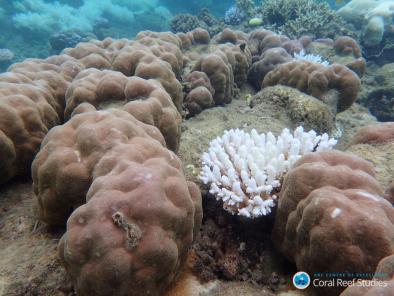





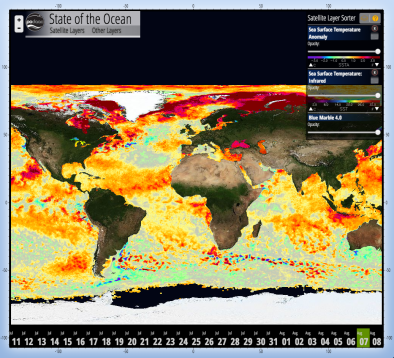
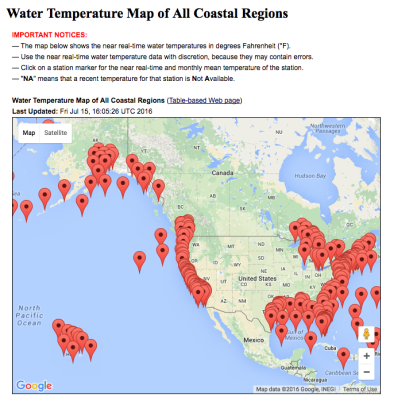
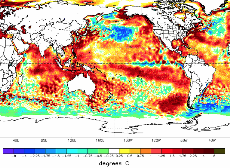
Table of Contents
Science at-a-glance
Introduction
Economic impacts
Temperature and bleaching
Bleaching sites: United States, Gulf of Mexico, Australia, Japan, Singapore, The Maldives, Tanzania, Fiji, New Caledonia, and Thailand
CO2 and acidification
Reef growth and acidification: Florida Reef Tract and the Great Barrier Reef
Science at-a-glance
- Global warming leads to increased sea surface temperature. In 2016, the global surface ocean temperature was 1.35°F (0.75°C) above the 20th century average, the warmest annual average in NOAA records dating from 1880–2016.
- Increased sea surface temperature makes mass coral bleaching events more frequent and severe. It also diminishes the amount of time between disturbances, which makes it more difficult for corals to recover.[1]
- Ocean acidification, driven by marine absorption of CO2, slows calcification, the process by which corals grow and rebuild.
Global warming of sea surface temperatures produced the longest global coral bleaching event on record
Global warming triggered the Earth’s third global coral bleaching event, and ocean acidification made it harder for reefs to recover. The Great Barrier Reef Marine Park Authority confirms that the event, which began in 2014, extended into 2017. It ended in June 2017, when a NOAA forecast showed that widespread bleaching was no longer happening in all three ocean basins.[2] It is the longest global coral bleaching event on record.[3] Due to record warm ocean temperatures, coral reefs from the South Pacific to Hawaii, from western Africa to the Caribbean are losing the symbiotic algae that feed and give them color. In many places, these organisms are even dying off. A 2016 analysis found that climate change made the observed warm temperatures in the Coral Sea, one of the bleaching locations, at least 175 times more likely to occur.[4]
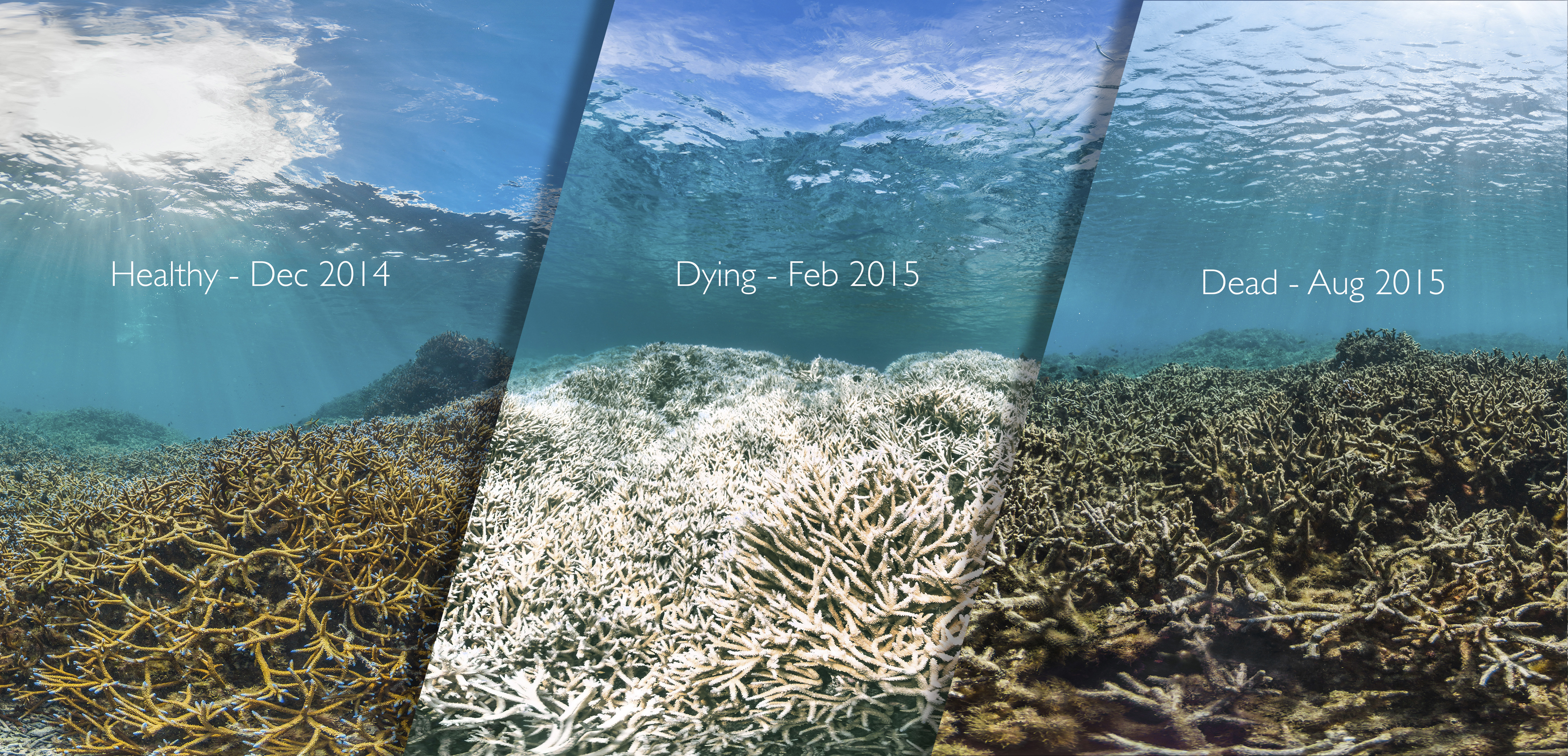 Reefs in the U.S., Australia, the Gulf of Mexico, Fiji, Japan, Thailand, Singapore, the Maldives, French territory New Caledonia, and Tanzania were affected.[5][6][7][8][9][10] The most recent, though limited, observations suggest that 33-50 percent of coral reefs worldwide had “been significantly degraded or lost” by the beginning of 2016. A more up-to-date picture of reef health across the Pacific will be available soon thanks to NASA’s CORAL campaign, which is collecting airborne spectral image data. The project is currently in its data acquisition phase, with science analysis to follow after 2017.
Reefs in the U.S., Australia, the Gulf of Mexico, Fiji, Japan, Thailand, Singapore, the Maldives, French territory New Caledonia, and Tanzania were affected.[5][6][7][8][9][10] The most recent, though limited, observations suggest that 33-50 percent of coral reefs worldwide had “been significantly degraded or lost” by the beginning of 2016. A more up-to-date picture of reef health across the Pacific will be available soon thanks to NASA’s CORAL campaign, which is collecting airborne spectral image data. The project is currently in its data acquisition phase, with science analysis to follow after 2017.
There is much at stake with these ecosystems, from global biodiversity to the basic needs of communities. A 2017 study published in the journal Science Advances found that in general, hot spots of marine biodiversity (defined as regions of marine biodiversity above the upper 95th percentile in terms of species richness) correspond with locations that are most severely impacted by global warming.[11] Reefs serve as a multi-purpose habitat for economically important fish species,[12] providing 17 percent of protein eaten globally.[13] They also filter pollutants out of ocean water, supply half of the earth’s oxygen, and absorb 30 percent of anthropogenic CO2 emissions.[13]
Economic impacts
Estimates of coral reefs’ contributions to the annual global economy vary. Approximations include $29.8 billion and $6.7 trillion.[12][13] NOAA estimates that reefs contribute over $100 million in commercial value to US fisheries.[12] In Australia, reef tourism generates $7 billion a year, employing almost 70,000 people and attracting 4,000,000 visitors annually.[14][15][16] The ecosystems are so crucial to the economy there that the Australian government petitioned UNESCO to omit its Great Barrier Reef chapter from its May 2016 climate change report, fearing that further publicizing damages would hurt tourism.[16]
Climate change-induced reef destruction could even eventually lead to a humanitarian crisis. For hundreds of millions of people in the developing world, reef fish are a primary source of protein.[17] A Food and Agriculture Organization report from 2014 stated that coral reefs provide up to 70 percent of protein eaten in coastal or island countries such as Fiji or the Maldives.[13]
Increased sea surface temperatures induce bleaching
About 93 percent of the heat trapped by greenhouse gas emissions since the 1970s has made its way into the oceans.[18] According to the Japan Meteorological Agency, annual average sea surface temperature (SST) of the global ocean has risen by +0.52°C over the last 100 years. IPCC models project further ocean warming in the top 100 meters of 0.9°F (0.6°C) to 3°F (2°C) by 2100, depending on future emissions reductions. For the top 1000 meters, the IPCC expects that warming will increase by 0.5°F (0.3°C) to 0.9°F (0.6°C).[18]
Under normal conditions, corals and their symbiont zooxanthellae algae (Symbiodinium spp.) enjoy a symbiotic relationship;[19][20] the corals provide the algae with shelter, and the colorful algae provide food for the corals via photosynthesis.[21] But when sea surface temperatures rise above average (typically by 1.0–1.5°C above seasonal maximum mean temperatures) in reefs that receive a relatively high amount of light,[22] the algae start producing toxic compounds, prompting the corals to expel them and turn white.[23] Once bleached, the corals are physiologically damaged and more susceptible to disease.[20][24] Widespread bleaching becomes likely when corals are exposed to more than four accumulated weeks of heat stress and excessive sunlight.[25][23]
It is possible for corals to recover,[21] but if water temperatures take too long to return to normal, the organisms actually starve and die.[21][26] Significant bleaching or death is possible after eight accumulated weeks of heat stress.[25]
A 2016 study found that the severe bleaching that year affected northern GBR reefs across the spectrum of water quality and protection from fishing pressure.[20] The results suggest that zoning reefs as no-entry or no-fishing and other local protection efforts do little to combat the negative impacts of marine heat stress.[20] Furthermore, reefs that had been more severely bleached in 1998 and 2002 were not less severely bleached in 2016; past bleaching did not have a protective effect.[20]
In the last three decades, 19 percent of global coral reef area has been lost due to coral bleaching.[26]Global-scale bleaching events were not observed until 1998.[27]
Above-average water temperatures observed at bleaching sites
Reefs in the U.S., Australia, the Gulf of Mexico, Fiji, Japan, Thailand, Singapore, the Maldives, French territory New Caledonia, and Tanzania have been struck by bleaching over the course of this global event.[5][6][7][8][9][10][6]
United States
The Florida coral reef tract was hit with particularly severe bleaching in 2014, and again in 2015, when a disease outbreak—to which corals are more susceptible when under stress—further compromised its health.[28][29] 2016 brought mostly mild to moderate bleaching, though the Upper Keys saw severe bleaching (meaning more than 50 percent of all >4cm corals surveyed in that area exhibited signs of bleaching/paling).[29] Looking longer-term, two key coral species in the Florida Keys—staghorn and elkhorn—have declined by 98 percent since the 1970s.[13]
It almost looks like it snowed on the reef.
Cory Walter, a senior biologist at the Mote Marine Laboratory in Florida, 2014[30]
Hawaii’s reefs experienced bleaching in 2014 as well as extensive bleaching in November 2015.[31][7] Researchers have found that sea surface temperature at Station ALOHA, 62 miles north of Kahuku Point, O‘ahu, is increasing at a rate of 0.22 degrees F per decade.[32] The increase is consistent with other estimates for temperatures around Hawaii.[32]
I could see what looked like bleached white ghosts popping up off the ocean floor at me.
Misaki Takabayashi, marine scientist at the University of Hawaii at Hilo, 2014[30]
Gulf of Mexico
NOAA's Flower Garden Banks National Marine Sanctuary saw mass mortality in July 2016 and major bleaching in October 2016.[8] According to a preliminary analysis of images from early October 2016, about 46 percent of colonies at shallow stations (60-80 feet deep) and 15 percent at deep stations (100-130 feet deep) were paling or bleached.[8] The sanctuary hadn’t been struck with bleaching of this magnitude since 2005, when 45 percent of its corals bleached or paled.[8]
Sea surface temperatures were above 30°C (86°F) for 85 days during the four-month period leading up to October 5th, 2016.[8]
Australia
Scientists confirmed in late-March 2016 that the bleaching event that began in 2014 is the worst ever observed in parts of the Great Barrier Reef.[33] It is the third mass bleaching event that has occurred there in the last two decades, following events in 1998 and 2002.[34] The earlier events harmed 43 percent and 56 percent of the system, respectively; in contrast, bleaching in 2016 alone harmed at least 85 percent.[35] Additionally, the proportion of reefs that underwent extreme bleaching in 2016 (extreme bleaching is defined as >60% of corals bleached) was more than four times that of 1998 or 2002.[20]
In the northern part of the Great Barrier Reef, 516 out of 520 reefs (over 99 percent of reefs!) surveyed by coral scientist Terry Hughes in early March 2016 showed signs of bleaching.[7] More than 95 percent were in the top two most severe bleaching categories,[7] which were 30 to 60 percent and over 60 percent bleached based on visual assessment.[20][7] In contrast, during a bleaching event in 2002, only 18 percent of reefs experienced such severe bleaching.[7]
By the end of May 2016, scientists found that corals in the Coral Sea region north of Cairns—covering about two-thirds of the Great Barrier Reef—had an average mortality rate of 35 percent, rising to more than 50 percent in areas around Cooktown.[36] As of June 2016, 22 percent of all the Great Barrier Reef’s coral was estimated to have been killed.[37][38] Eighty-five percent of those deaths were north of Lizard Island, where there was a 50 percent mortality rate.[38] About 16 percent of the coral in the tourist-heavy area to the south had perished.[38]
Water temperatures in the Coral Sea were record warm in March of 2016.[39] Average ocean temperatures around Australia are now 0.68°C above the 1910-1929 average.
Japan
A survey conducted by Japan’s Ministry of the Environment in November and December 2016 found that 90 percent of the Sekisei lagoon, the country’s biggest coral reef, was bleached.[40] Seventy percent was found to be dead.[40]
The Japan Meteorological Agency reported that between June and August 2016, average sea surface temperature (SST) in the southern Okinawa islands—at 30.1°C or 86.18°F—was the highest it’s been since the record started in 1982.[40] According to the Japan Meteorological Agency, annual average SST around Japan is 1.07°C higher than it was a century ago.
Singapore
The National Parks Board estimates mortality from 2016 bleaching in Singapore’s reefs at 15 to 20 percent. Past major bleaching events in 1998 and 2010 brought 20 percent and 12 percent mortality, respectively.[9]
Water temperatures around Singapore rose above the bleaching threshold of 31.14°C earlier in the year than they had in 1998—in April rather than August, according to adjunct research professor Chou Loke Ming of the National University of Singapore's Tropical Marine Science Institute.[9] Between April and October, temperatures dropped, but remained above 29.6°C, the average for the time of year.[9]
The Maldives
The Maldives Marine Research Centre and the Environmental Protection Agency conducted a study with the International Union for Conservation of Nature at the apex of the bleaching event of 2016.[41] These groups found that bleaching had reached about 60 percent of reefs in the Maldives, and even 90 percent in some areas.[41]
Tanzania
A bleaching event occurred between February and June 2016 on the Tanzanian coast, though the observed mortality rate was very low in Dar es Salaam and Zanzibar reefs.[10] However, during the 1997-1998 global bleaching event, up to 80 percent of some Tanzanian reefs died.[10]
Sea surface temperatures were 2°C above average during the 1997-1998 event.[10]
Fiji, New Caledonia, and Thailand
Reefs in Fiji and New Caledonia underwent extensive bleaching in February 2016,[7] and Thailand’s reefs experienced some bleaching in 2016 as well.[5]
More CO2 in the air means more acidification in the ocean
 Ocean acidification—driven directly by rising CO2 levels in the atmosphere—is progressing steadily and measurably, taking a toll on sea life. Acidification is having a significant impact on the chemical composition of seawater. This change in ocean chemistry is threatening the healthy development of many marine species, and poses risks to the humans who depend on oceans for their livelihoods.
Ocean acidification—driven directly by rising CO2 levels in the atmosphere—is progressing steadily and measurably, taking a toll on sea life. Acidification is having a significant impact on the chemical composition of seawater. This change in ocean chemistry is threatening the healthy development of many marine species, and poses risks to the humans who depend on oceans for their livelihoods.
The ocean has absorbed about one quarter of the CO2 released into the atmosphere since preindustrial times.[18] In the same time period, the pH of surface seawater has decreased from about 8.2 to 8.1.[18] While the ocean is still “basic” because it is above 7 on the pH scale, dissolved CO2 acidifies the ocean by increasing the concentration of hydrogen ions.
Here’s the step-by-step process:
- Dissolved CO2 reacts with water (H2O) to form carbonic acid (H2CO3)
- Hydrogen ions (H+) from the carbonic acid split off, leaving bicarbonate ions.
- These hydrogen ions react with carbonate ions (CO32-) to form more bicarbonate ions (HCO3-).
- Increasing numbers of carbonate ions get pulled into these reactions. As a result, there are fewer carbonate ions available for marine organisms to use in their shells and structures, which are made out of calcite (calcium carbonate aka calcium plus carbonate).
The pH change from 8.2 to 8.1 corresponds to a 26 percent increase in acidity (or hydrogen ion concentration) and is likely the fastest acidification rate in 300 million years.[18] Without concerted action to reduce global CO2 emissions, oceanic pH could drop to 7.8 by the end of this century. That would be a huge change, representing a 150-percent increase in acidity. Such an alteration in the marine environment could have devastating results, both for marine species and the people who depend upon them.
Corals use calcium carbonate to build their structures, so this change in ocean pH affects their health. The rate and magnitude of climate disruption on reefs is already testing the ability of organisms to adapt, leading to increased risk of extinction, biodiversity loss, and the compromising of ecosystem services. Ecosystems depend upon biodiversity to be healthy and to ensure protection against disruption and disaster. As ocean temperature increases, only the most resilient species, able to thrive in a warmer climate, will survive.
Ocean acidification is slowing reef growth and recovery
While increased sea surface temperature put reefs at risk of bleaching and death, ocean acidification hinders coral growth and even paves the way for reef structures to dissolve.[6][42] Findings from studies of the Florida Reef Tract and the Great Barrier Reef have broader implications for reefs in a warming world with increasing amounts of CO2 in the atmosphere.[43]
Florida Reef Tract
Scientists have been wondering when reefs will start dissolving more quickly than they can calcify.[42]Past studies had concluded that reefs probably wouldn’t reach that tipping point until closer to the middle of this century.[43] However, researchers at the University of Miami and Florida International University found that the intensity of acidification in the Florida Keys’ northernmost reef is such that that reef is already net erosional on an annual basis.[42] The researchers’ surveys and chemical analysis of water samples, conducted in 2009 and 2010, showed that reefs further south were in better shape.[43] During fall and winter, the more southern reefs eroded more quickly than they rebuilt; but during spring and summer, they grew more quickly than they eroded.[42] Over the course of an entire year, they were net depositional.[42] The two southernmost reefs were the only ones that consistently had greater rates of calcification than disintegration.[42]
Great Barrier Reef
In a study published in Nature in 2016, researchers recreated pre-industrial ocean conditions over part of the GBR by bringing in seawater that had been altered to make it more alkaline.[44] They found that coral that came into contact with the altered seawater grew seven percent faster than other coral.[44] This suggests that today’s acidified seawater may already be less conducive to calcification than more alkaline seawater from pre-industrial times.[44] Slower growth makes it harder to recover from recurring insults like bleaching.
Related Content








